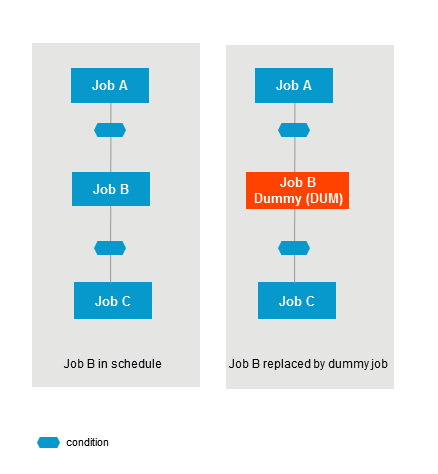The execution of a dummy job means that the job is running without job
control and without its own action within Entire Operations. A dummy job is
directly executed by the prerequisite checking routine. A dummy job always
terminates with the state o.k..
A dummy job is useful for several reasons:
Testing the job flow when creating or changing a network.
Finding erroneous jobs in a chain of concatenated jobs.
Excluding or including a job from a chain of concatenated jobs without having to change job queues and adapting job definitions.
Excluding jobs that execute tasks that are not frequently required to avoid overhead, balance workload and improve performance.
This document covers the following topics:
Permanent dummy jobs are declared with the job type
Dummy Job (DUM) in the job master
definition.
Permanent dummy jobs execute with the estimated elapsed time, which is defined for the job. This does not block any queues within the Entire Operations Monitor.
In principle, you can execute any type of job as a temporary dummy job. An active job that fulfills any of the conditions described under Dummy due to Condition is always executed as a dummy for a particular run.
Temporary dummy jobs with the job type Standard Job
(JOB) have a master JCL definition (see
Defining and Managing JCL for a
Job).
Temporary dummy jobs always have the execution time zero, regardless of which estimated elapsed time is defined for the job.
During its activation or during a prerequisite check, a job can be
put into the state temporary dummy job for the following
reasons:
| Dummy due to Condition | Description |
|---|---|
| Definition | If the special type Execute as dummy
(D) is set in the job master definition, the JCL
definition can be maintained, but the execution as a dummy job can be
forced.
|
| Schedule | Depending upon the schedule of the network or upon a
calendar, a job can be submitted as a temporary dummy job on particular days.
For further information, see Maintaining Schedule Dependencies for a Job. |
| Prerequisite | It can be defined that the existence or non-existence of
an active prerequisite results in execution as a temporary dummy job.
For further details, see Possible References for Input Conditions. |
| Recovery Action | If a job is not to be submitted again in the case of a
defined recovery action.
For details, see Defining Recovery Actions. |
| JCL check | Execution of the job control in the mode JCL
check.
Thus, jobs (see Fields: Job Activation) or Job Networks (see Fields: Network Activation) are activated for the JCL check. |
| Empty JCL | If the loading process of the job control reveals that
the JCL is empty, the job is submitted as a temporary dummy job.
This state can result from the JCL generation by means of macro instructions, for instance. |
| Multiple Suffixes | If the activation is to take place by means of multiple suffixes: if the multiple-value symbol used does not contain any occurrences, then a dummy job is activated as a placeholder in the network during activation. |
You can exclude a job from actual execution on certain schedule or calendar days without disturbing the job network structure. If a job is not to be activated, it can be converted into a dummy job just for this run. For example:

You can use the Schedule Dependency feature to define job activation or input condition usage to be checked only on certain days. In this case, you can execute a job as a dummy job without changing any job definitions.
For information on using the Schedule Dependency feature, see Maintaining Schedule Dependencies for a Job in the section Schedule Maintenance.
Running jobs are checked as to whether they have exceeded their predefined deadline time.
If this is the case, a message:
is sent to all mailboxes linked to the network;
is written to the log;
appears in the List Active Jobs, Active Job List or List Active Jobs Job Active window.